Dried shrimp sambal or heé bee sambal (or heé bee hiam) in Hokkien is a spicy condiment that is loved by everyone (for those who know the existence of this dish. I can bet about that!). Grandma used to make dried shrimp sambal for us when we were young. But not anymore as cooking time is tedious and slow. An old lady cannot stand doing that. But when her granddaughter requested her to teach the recipe, she said YES! immediately. According to grandma it was her mom who taught her to make dried shrimp sambal. Awww I miss my great-grandma.
Together we make a good team; grandma and me. She ordering me around for the preparation and cooking and not forgetting the occasion huffs and puffs she gave out because yours truly was taking some time snapping pictures of the process. Hahaha
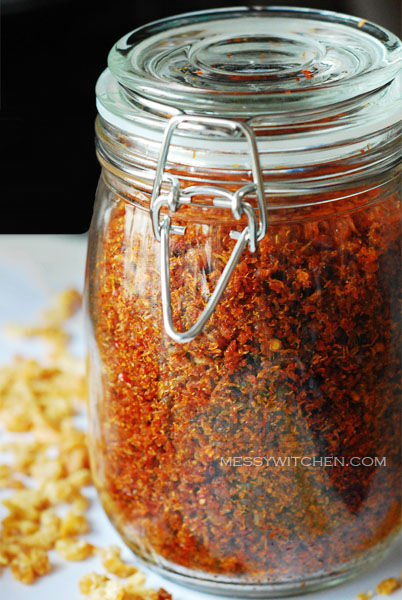
Before you proceed, I need to tell you something: You will need a lot of patience and time if you plan to make this. 😛 Patience because you need to stir-fry the ingredients almost non-stop. Time because you need about 1 hour of cooking time. Hehehe But worry not, once you’re done you will have a month supply of dried shrimp sambal!
First thing first,
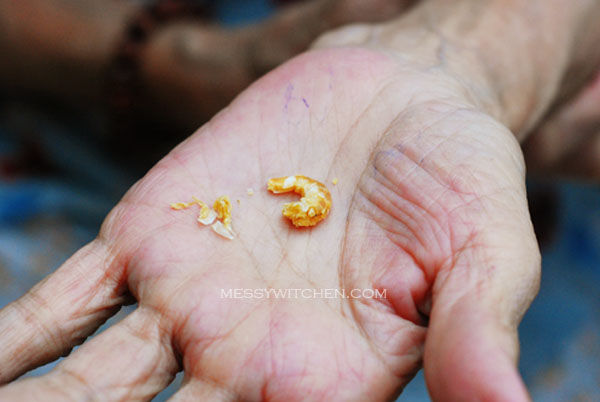
You need to clean the dried shrimp. One by one, remove the shell and dirt (if any).
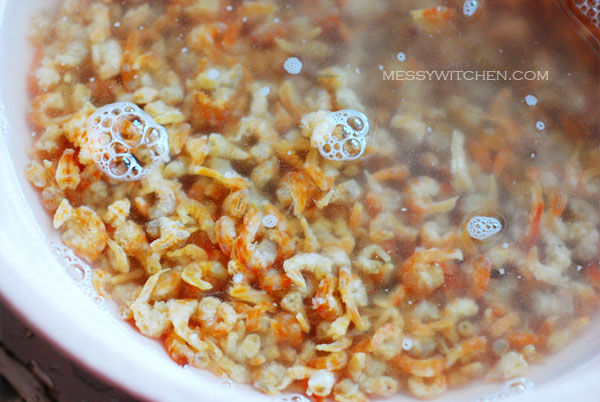
Then soak in cold water. If you’re in a hurry you can soak dried shrimp in warm water so that it will soften faster. For us, we have ample time since we are going to prepare other ingredients.
Next is the dried chili.
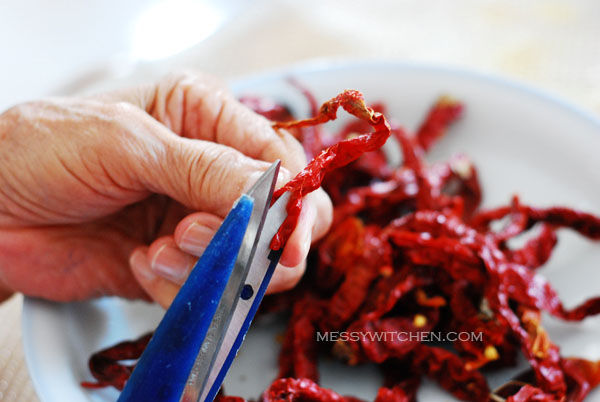
Use a scissor and cut off the head. Then cut along the body of the chili about 3/4 way.
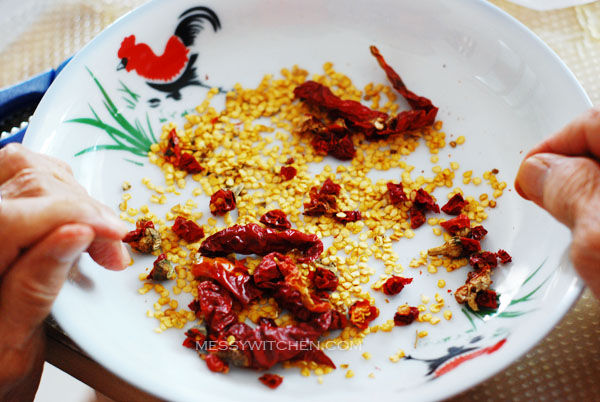
Get the seeds out. You don’t have to be so thorough as rinsing later will remove the seed as well. Also you gotta leave some for some ‘kick’ right?
Next, peel garlic and shallots. Rinse well too.
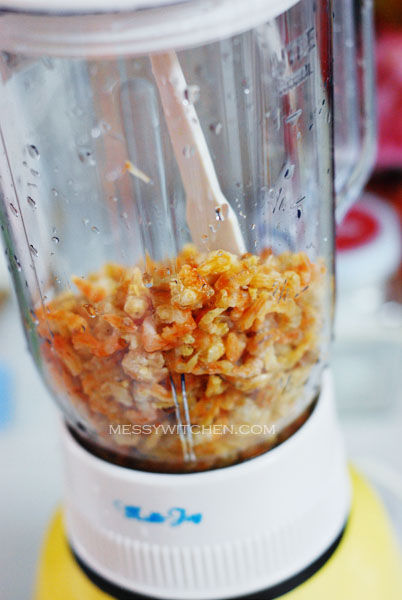
Rinse soften dried shrimp well just before going into blender. You have to blend it in 2 to 3 rounds to a coarse texture (since the quantity is a lot). Add some water before blending.
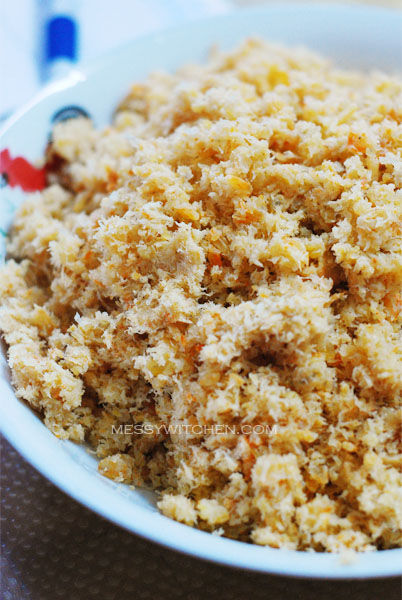
Blended dried shrimp. You can use a mortar and pestle to pound dried shrimp. But I’m lazy and it’s hard work.
Next blend dried chilies (with some water) and garlic & shallots.

Clockwise from top: Blended dried shrimp, garlic & shallots paste and chili paste.

In a heated wok, add enough oil to cover blended garlic and shallots paste. Stir-fry garlic and shallots paste until fragrant. Took me about 14 minutes.

Next add chili paste.
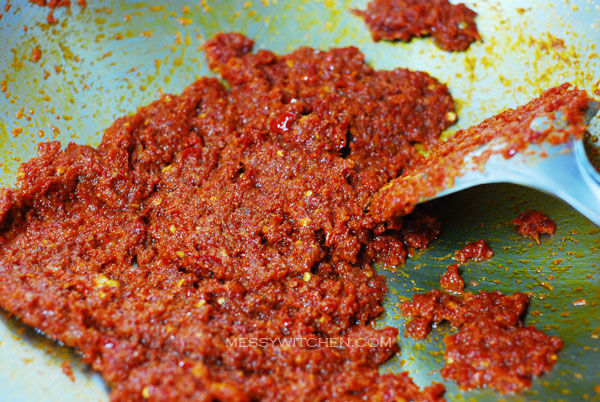
Stir-fry for about 6 minutes.
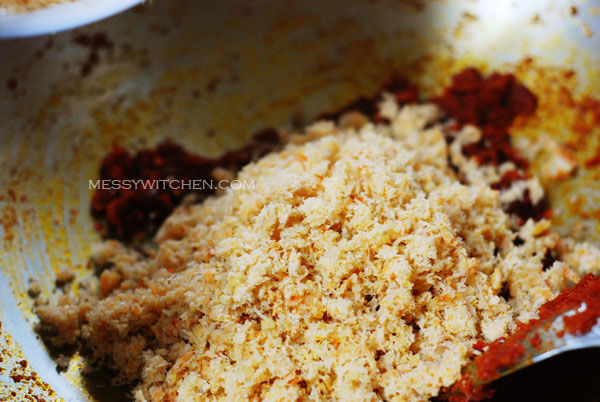
Add blended dried shrimp. Combine all the ingredients well. You need to stir always so that it won’t stick to the wok.
Next, add sugar and tamarind peels 5 minutes later.
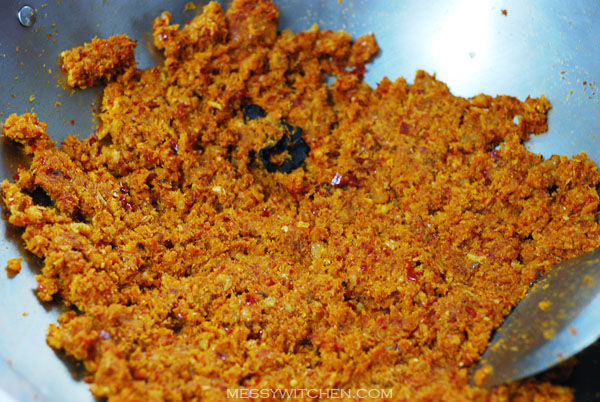
The black thingy is tamarind peel. Continue to stir-fry, always moving your wok turner. Along the way do add some oil if you feel it’s too dry.
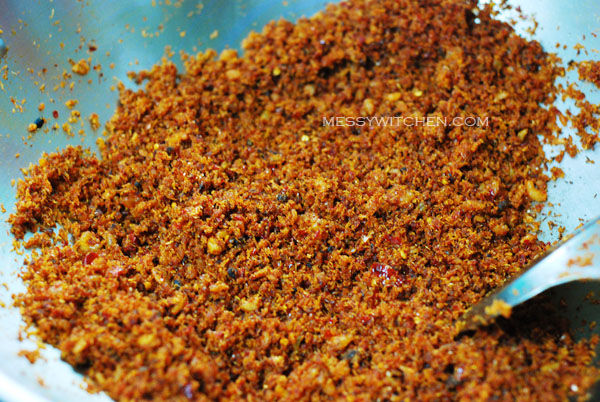
Fry until it is very dry. Took about 36 minutes from adding blended dried shrimp to completion. Remove tamarind peel once you’re done.
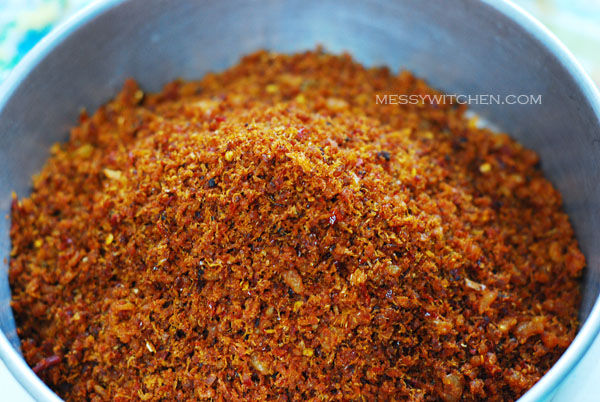
Transfer dried shrimp sambal to a tray and leave to cool.

Store in a clean, dry and air-tight jar once cool. This is a 1L jar which fits just perfectly. If you’re not going to finish this jar by 2 weeks it’s best to keep in the fridge (if your place is warm) or you can return it to the wok and stir-fry it again to prevent molding.

Dried shrimp sambal is spicy and aromatic. The spiciness won’t kick in until you’ve munch a little bit of it. Best eaten with rice, mee huen kueh, pan mee, bread… what else?
You can also use this recipe to make mini dried shrimp sambal spring roll for Chinese New Year.
If you’re not a spicy person, just lessen the dried chili quantity.
Grandma’s Dried Shrimp Sambal
280g dried shrimp, remove shell, soaked and rinsed
185g shallots, peeled
40g garlic, peeled
40g dried chili, remove seed and rinsed
1 1/2 tamarind peel
2 tablespoon sugar
oil (vegetable or palm)
Method:
1. Blend soften dried shrimp in 2 to 3 rounds (since the quantity is a lot) to a coarse texture. Add some water before blending. Set aside.
2. Blend dried chili to a paste. Add a little water so it can blend well. Put aside as well.
3. Blend garlic and shallots to a paste.
4. Heat wok and add oil (enough to cover blended garlic and shallots paste).
5. In medium heat, stir-fry garlic and shallots paste until fragrant. [For me it took about 14 minutes.]
6. Add chili paste and again stir-fry until aromatic. [For me it took about 6 minutes]
7. Finally add blended dried shrimp and stir-fry.
8. Add sugar and tamarind peels about 5 minutes later.
9. Add some oil if it’s too dry. Remember you need to continue working with the ingredients (stir-fry) so that it won’t stick to the wok. Fry until it is very dry. [For me, it took about 36 minutes from adding blended dried shrimp to completion]
10. Remove tamarind peel once you’re done.
11. Transfer dried shrimp sambal to a tray and leave to cool.
12. Once cool, store in a clean, dry and air-tight jar.
Enjoy the sweat! 😛




36 Comments
very delicious. BOught before
Are they expensive? Coz dried shrimps are pricey nowadays.
Wah I love the colours…
The color of hotness. Haha
so delicious, I too make this at home, its wonderful with soups and as sandwich filling.
Soup? Ooo I haven’t tried that.
My last purchase long ago was RM30++ for 1KG @_@ How about now??
Amy i missed your cooking and pictures, they are simply amazing!!
I have not been cooking as my fiance is out of the country and i still have so much of left over in the fridge and taking forever to clear! As you know i eat very little at night 😀
Can’t wait for more of your recipes and pictures ^___^
Ohh I bought RM15 for 300g. Arrghh me kena tipu?
You’re too generous my dear.
Ah ha now I know why you eat so little at night. Getting ready to fit the bridal gown? Tsk tsk hehe
Wow. What an amazing series of photos! I enjoyed seeing your grandmother’s hands. You’re so lucky to be able to record such a great moment through your blog photos. The dried shrimp sambal looks amazing. Goodness!!
Thank you 🙂
Loving my grandma. These photos will be a treasure from years to come.
They really are beautiful pictures. Treasures for sure 🙂 stirred the emotions.
Thank you Ali. ❤️
Sambal hei bee is nyonya, I think. My mom makes them all the time but not anymore. I still remember have to tumbuk the ingredients for her when I was younger, no blender or Bamix yet. We eat it with porridge too, but the best is plain white rice, add some sambal hei bee and some kat chai juice to it….so yummy. Sandwich is also my fav.
Yeah it’s nyonya. Grandma told me “Wah so easy eh use blender.” Haha
Ohh yeah porridge! Nyonya version of hee bee sambal include kat chai leaves if I’m not mistaken.
NOlahhh, not to fit into the bridal gown lah, but vain enough and trying hard to upkeep my ‘dropping’ market valeu!! *ahem ahem* hahahahha…..
Err, maybe not that you kena tipu lah, probably my purchase was long ago! Inflation!!! Kekekekek
Looking forward to more of your posts! ^_____^
Market value drop? Weh you’re already engaged. Don’t care la. Hahaha
Yeah I guess inflation.
Thank you for sharing your precious recipe! Appreciated.
Hi Jo, you’re most welcome 🙂
Anyone can tell me if I can buy pre-made ones in California?? I love these, my dad use to get it for me from Thailand, Burma, etc when he traveled there. But now he doesn’t go there anymore. really want some!!
Hi Pearline, I guess you can try looking at Asian stores.
i love you for this recipe. You have helped me achieve a dish i used to eat made fresh by mom. After she expired my tongue, literally, died eating from hotels and other places. Thank you and words are not enough, my lady.
Hi, Glad I can help. Is this the same as Indian version?
I wish I had my grandmommy around; She is a nyonya you see.
Thank you very much for posting this. I have been devising a way to prepare the condiment from scratch and nailed most of the ingredients; A guideline such as yours is fairly appreciated.
Tell granny I said thanks and hi 🙂
Hi Clockwork, You’re welcome.
Sure I’ll tell her. 🙂
Sorry, what is tamarind in dialect?
Your method 10 – remove tamarind peel once you’re done – pl elaborate.
Tks
Hi, Tamarind peel is asam gelugor or asam keping in bm. I’m not sure what it’s called in Chinese dialect.
Step 10 means discard tamarind peel.
Please tell me what tamarind peel is. Thank you.
Hi, it’s dried slices of a sour fruit called Tamarind. You can get this from Asian market.
If I can’t find the tamarin peel, can I just substitute with tamarin paste?
Hi Jess, according to my grandma yes you can substitute with tamarind paste.
I think it is not called tamarind, tamarind usually cannot be sliced because they ushally sell the ripe ones for cooking and its soft and paste like.. Mushy. If you are talikng about slices of sout thingy from the Asian market perhaps its asam gelugor or asam keping from the fruit scientifically known as Garsinia Cambogia.. The one claim to be effective for weight loss.. Am I right I will find a pic.. ILOVE THIS RECIPE btw Thanks for sharing.. Lots of love..
Hi Sue, yes it’s asam keping/asam Gelugor. In English it’s called tamarind peel or tamarind slice. I just refer to two Nyonya cookbooks. Both called it tamarind peel and both are referring to asam keping/asam Gelugor. Tamarind paste is made from asam jawa. It’s confusing ya.
i think what you refer to is known as Kokum in India and the UK. The fruit looks like a small plum, and the flesh and skin when dried turns black and is used to add sourness to fish curries in some parts of India (although some people use tamarind). If you soak the kokum in water it makes a purple liquid – add sugar and you have kokum sherbet 🙂 It isd also known as “sol” in Goa, and there they also mix with some toasted garlic, chilli, coriander and coconut milk and some frsh chopped coriander leaves to make solkudi which can be served with white rice and makes a delicious savoury drink. 🙂
Che-Cheh, your recipe looks delicious and I’m going to try it. Can it also be made with the whole tiny dried shrimps that come with shells on?
Hi Neil, I think you can use those. The taste will definitely be different. Some of the tiny dried shrimps have tough shells, so you need to remove them. Do let us know the end result ya.
add a whole lot more oil, dried scallops, chinese preserved ham and you have XO Sauce! YUMM!!! this sounds fabulous!
Hi Kayenne, never tried XO sauce so I don’t know how it tasted like.